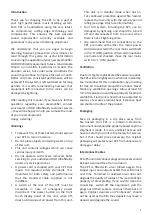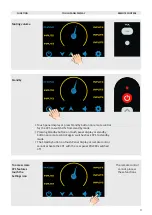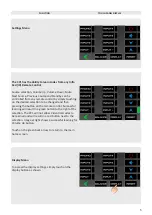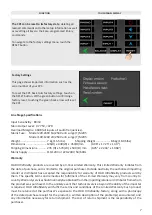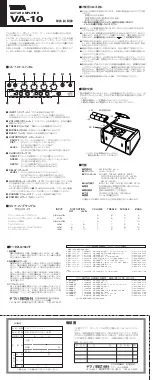
8
Phono Specifications
Frequency response: RIAA /- 0.05dB
Signal to Noise Ratio (10mV input)
MM cartridge:
>107 dB A-weighted, input shorted
MC cartridge:
> 85 dB A-weighted, input shorted
Input Sensitivities:
MM cartridge:
2mV/47kOhm/100pF
MC cartridge:
100uV/200R balanced differential/1nF
Overload Margins:
MM cartridge:
40dB (20 - 20kHz) for 2mV input
MC cartridge:
40dB (20 - 20kHz) for 100uV input.
Introduction
The CP1 phono card gives vinyl playback with the lowest noise figure possible. The phono card is able to
play extremely low output moving coil (MC) cartridges without a step-up transformer. The extremely low
noise and high gain design of the phono card is capable of cleanly and quietly delivering a line level signal
output with a phono cartridge input of down to 80 micro-volts.
Cartridge loading is automatic when connecting a MC cartridge due to its unique design. For moving
magnet (MM) cartridges, parallel capacitance loading is provided for. Parallel capacitance can be adjusted
from 100 pF to 750 pF.
Adjustment of switches
Adjustment is to be made with the CP1 switched off or better still with your power amplifier switched off.
Changes made to the phono card loading have the possibility of sending pulses to your power amplifier
that could damage speakers if the volume of the preamp is set sufficiently high.
On the rear panel you will see two sets of DIP switches. These switches allow you to select cartridge type
(moving magnet or moving coil), select gain, and adjust cartridge loading.
Just above these DIP switches you will see graphic representation of how the two pairs of switches can be
adjusted. Switches 6,7 & 8 of DIP switch on the right have no effect and should be ignored. The phono card
ships from the factory with a default setting of moving coil at 100 ohms with a gain of 71 dB.
In order to set the switches for your particular cartridge, you will need to have some knowledge of its
specifications. If you do not have that cartridge information, please contact your dealer or OAD directly.
We will attempt to help you with that data, however we do not have factory data on every cartridge ever
built. Select Moving Magnet (MM) or Moving Coil (MC) according to the type of cartridge you have. In all
instances the switch-tab for any selection will need to be down for ‘on’ and up for ‘off’.
Gain setting (G)
The gain control attenuates the overall gain of the phono card stage in such a way that when the gain is
reduced, the noise levels seen at the output of the CP1 are reduced proportionally. In this way, there is no
penalty in selecting one gain setting over another. The exemplary signal, distortion and noise figures of the
CP1 are never compromised by changing gain settings.
Choose a gain setting that allows the volume control to operate within a range similar to that of your other
source components. If phono is your only source component, then pick a gain setting that allows your
preamp a fairly advanced gain setting at whatever you consider to be a comfortable listening level. In most
cases, set gain switch up for MC cartridges and down for MM cartridges.
Moving Coil setup
For MC cartridges, switch 4 (MM) of both DIP switches are set to up for ‘off’.
In MC mode, parallel capacitance is switched out and has no effect.
All technical specifications are subject to change without prior notification.



